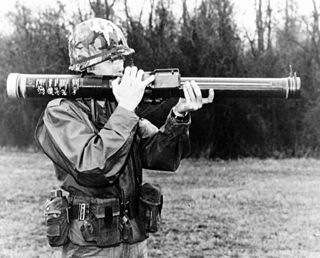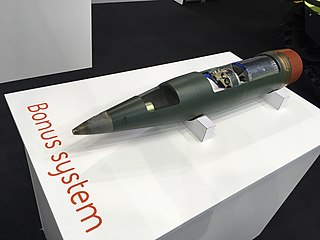
A land mine, or landmine, is an explosive weapon often concealed under or camouflaged on the ground, and designed to destroy or disable enemy targets as they pass over or near it. Land mines are divided into two types: anti-tank mines, which are designed to disable tanks or other vehicles; and anti-personnel mines, which are designed to injure or kill people.

A cluster munition is a form of air-dropped or ground-launched explosive weapon that releases or ejects smaller submunitions. Commonly, this is a cluster bomb that ejects explosive bomblets that are designed to kill personnel and destroy vehicles. Other cluster munitions are designed to destroy runways or electric power transmission lines.
The GATOR mine system is a United States military system of air-dropped anti-tank and anti-personnel mines developed in the 1980s to be compatible with existing cluster dispensers. It is used with two dispenser systems—the Navy 230 kg (500 lb) CBU-78/B and the Air Force 450 kg (1,000 lb) CBU-89/B. Additionally the mines are used with the land- and helicopter-based Volcano mine system.

Anti-tank warfare originated during World War I from the desire to develop technology and tactics to destroy tanks. After the Allies deployed the first tanks in 1916, the German Empire introduced the first anti-tank weapons. The first developed anti-tank weapon was a scaled-up bolt-action rifle, the Mauser 1918 T-Gewehr, that fired a 13.2 mm cartridge with a solid bullet that could penetrate the thin armor used by tanks at that time and destroy the engine or ricochet inside, killing occupants. Because tanks represent an enemy's strong force projection on land, military strategists have incorporated anti-tank warfare into the doctrine of nearly every combat service since. The most predominant anti-tank weapons at the start of World War II in 1939 included the tank-mounted gun, anti-tank guns and anti-tank grenades used by the infantry, and ground-attack aircraft.

The AGM-154 Joint Standoff Weapon (JSOW) is a glide bomb that resulted from a joint venture between the United States Navy and Air Force to deploy a standardized medium-range precision-guided weapon, especially for engagement of defended targets from outside the range of standard anti-aircraft defenses, thereby increasing aircraft survivability and minimizing friendly losses. It is intended to be used against soft targets such as parked aircraft, trucks, armored personnel carriers (APCs), and surface-to-air missile sites (SAMs). Prior to launch, it is given a destination through either a predesignated waypoint or a point marked through a targeting pod. It glides, using two wings that pop out for added lift, to the marked destination and dispenses submunitions in a short, roughly linear pattern. The designation of the Joint Standoff Weapon as an "air-to-ground missile" is a misnomer, as it is an unpowered bomb with guidance avionics, similar to the older GBU-15.

The M270 Multiple Launch Rocket System is an American armored self-propelled multiple launch rocket system.

The CBU-97 Sensor Fuzed Weapon is a United States Air Force 1,000-pound (450 kg)-class freefall Cluster Bomb Unit. It was developed and produced by Textron Defense Systems. A CBU-97 used in conjunction with the Wind Corrected Munitions Dispenser guidance tail kit is converted to a precision-guided weapon, and the combination is designated CBU-105.

A dual-purpose improved conventional munition (DPICM) is an artillery or surface-to-surface missile warhead designed to burst into submunitions at an optimum altitude and distance from the desired target for dense area coverage. The submunitions use both shaped charges for the anti-armor role, and fragmentation for the antipersonnel role, hence the nomenclature "dual-purpose". Some submunitions may be designed for delayed reaction or mobility denial (mines). The air-to-surface variety of this kind of munition is better known as a cluster bomb. They are banned by more than 100 countries under the Convention on Cluster Munitions.
An active protection system (APS) is a system designed to actively prevent certain anti-tank weapons from destroying a vehicle.
The FGM-172 SRAW, also known as the Predator SRAW, was a lightweight, close range missile system produced by Lockheed Martin, developed by Lockheed Martin and Israel Military Industries. It is designed to complement the FGM-148 Javelin anti-tank missile. The Predator had a longer range and was more powerful than the AT4 that it was designed to replace, but had a shorter range than the Javelin.

A top attack weapon is designed to attack armored vehicles from above, to take advantage of the fact that the armour is usually thinnest on the top of an armoured vehicle. The device may be delivered as a smart submunition or a primary munition by an anti-tank guided missile (ATGM), mortar bomb, artillery shell, or even an emplaced munition such as a mine. Top attack munitions use either a shaped charge warhead, or an explosively formed penetrator (EFP) warhead fired while over the target.
The Korean Smart Top-Attack Munition (KSTAM) is a smart munition intended to be launched from the gun of a main battle tank, namely the South Korean K2 Black Panther. Comparable systems include Diehl Corporation's Spear, DRDO SAMHO, CMI Defence and Luch Falarick 120, Israeli Aerospace Industries LAHAT, Nexter Systems Polynege, Alliant Techsystems STAFF and MRM-KE, Raytheon Technologies MRM-CE, and the two final companies' TERM.
The CBU-87 Combined Effects Munition (CEM) is a cluster bomb used by the United States Air Force, developed by Aerojet General/Honeywell and introduced in 1986 to replace the earlier cluster bombs used in the Vietnam War. CBU stands for Cluster Bomb Unit. When the CBU-87 is used in conjunction with the Wind Corrected Munitions Dispenser guidance tail kit, it becomes much more accurate, and is designated CBU-103.

Selectable Lightweight Attack Munition or is a small United States multi-purpose landmine produced by ATK Precision Fuze Company in Janesville, Wisconsin from 1992 to 2002. It has a passive infrared sensor, and a magnetic influence sensor which allow it to be used as a demolition munition, off-route mine, or full width belly attack mine.
The Northrop Grumman Brilliant Anti-Tank (BAT) is a United States submunition round dispensed from a missile. It is capable of independently identifying and attacking armored vehicles. The BAT uses acoustic sensors to identify its intended targets, and an infrared homing (IR) terminal seeker to image and aim at the attack target.

A precision-guided munition (PGM), also called a smart weapon, smart munition, or smart bomb, is a type of weapon system that integrates advanced guidance and control systems, such as GPS, laser guidance, or infrared sensors, with various types of munitions, typically missiles or artillery shells, to allow for high-accuracy strikes against designated targets. PGMs are designed to precisely hit a predetermined target, typically with a margin of error that is far smaller than conventional unguided munitions. Unlike unguided munitions, PGMs use active or passive control mechanisms capable of steering the weapon towards its intended target. PGMs are capable of mid-flight course corrections, allowing them to adjust and hit the intended target even if conditions change. PGMs can be deployed from various platforms, including aircraft, naval ships, ground vehicles, ground-based launchers, and UAVs. PGMs are primarily used in military operations to achieve greater accuracy, particularly in complex or sensitive environments, to reduce the risk to operators, lessen civilian harm, and minimize collateral damage. PGMs are considered an element of modern warfare to reduce unintended damage and civilian casualties. It is widely accepted that PGMs significantly outperform unguided weapons, particularly against fortified or mobile targets.
The SMArt 155 is a German 155 mm guided artillery round designed for a long-range, indirect fire top-attack role against armoured vehicles. The projectile was developed in 1989 by Diehl BGT Defence in Überlingen, Germany, with Rheinmetall and started full-rate production for the German Army in 1998. It consists of a 47-kilogram (104 lb) heavy artillery projectile containing two autonomous, sensor-fused, "fire-and-forget" submunitions. Due to the submunitions, it has been considered by some to be a cluster munition. As of 2008, representatives of the German defense ministry have referred to it as not being classified as submunition weapons, which were prohibited by the 2008 Convention on Cluster Munitions.

The BONUS or ACED is a 155 mm guided artillery cluster round co-developed and manufactured by Bofors of Sweden and Nexter of France. It was designed to fulfill a long range, indirect fire, top attack requirement against armoured fighting vehicles.
A loitering munition, also known as a suicide drone, kamikaze drone, or exploding drone, is a kind of aerial weapon with a built-in warhead that is typically designed to loiter around a target area until a target is located, then attack the target by crashing into it. Loitering munitions enable faster reaction times against hidden targets that emerge for short periods without placing high-value platforms near the target area and also allow more selective targeting as the attack can be changed mid-flight or aborted.
The XM1100 Scorpion, formerly known as the Intelligent Munitions System, was an anti-vehicle, smart ground munition developed by Textron Defense Systems as a safer alternative to traditional landmines. The Scorpion was originally a component of the Future Combat Systems program. It was a remotely controlled, integrated system of lethal and non-lethal munitions, ground sensors, and communication technology that could autonomously detect, track, and destroy light-wheeled to heavy-tracked vehicles.










